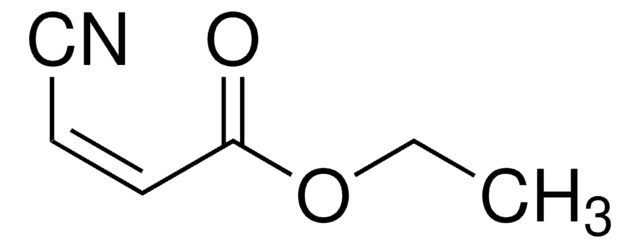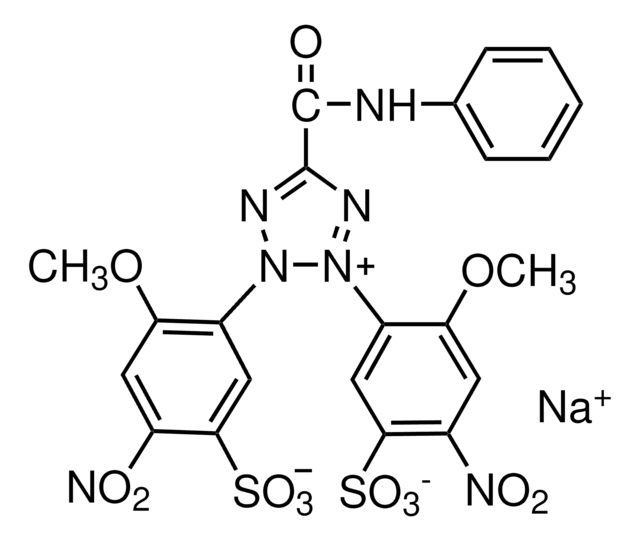E1505
Ethyl 2-cyanoacrylate
liquid
Synonyme(s) :
ethyl 2-cyanoprop-2-enoate
Se connecterpour consulter vos tarifs contractuels et ceux de votre entreprise/organisme
About This Item
Formule empirique (notation de Hill) :
C6H7NO2
Numéro CAS:
Poids moléculaire :
125.13
Numéro CE :
Numéro MDL:
Code UNSPSC :
12162002
ID de substance PubChem :
Nomenclature NACRES :
NA.23
Produits recommandés
Forme
liquid
Température de stockage
2-8°C
Chaîne SMILES
CCOC(=O)C(=C)C#N
InChI
1S/C6H7NO2/c1-3-9-6(8)5(2)4-7/h2-3H2,1H3
Clé InChI
FGBJXOREULPLGL-UHFFFAOYSA-N
Description générale
Ethyl 2-cyanoacrylate belongs to the class of monomers known as cyanoacrylates. Ethyl 2-cyanoacrylate polymers are primarily used as adhesives due to their fast-setting and strong bonding properties. They are widely utilized for bonding a variety of materials, including metals, plastics, rubber, ceramics, and wood. These adhesives are used in industries such as automotive, electronics, crafts, and general repairs. Ethyl 2-cyanoacrylate adhesives find applications in industrial and manufacturing processes. They are used for sealing products, encapsulating electronics, and securing parts during assembly.
Application
Ethyl 2-cyanoacrylate, commonly known as super glue, has several uses in the field of bioadhesives:
- Wound Closure: Ethyl 2-cyanoacrylate is often used in medical settings to close small cuts and wounds. It forms a strong bond when it comes into contact with moisture, effectively sealing the wound.
- Tissue Adhesives: In surgical and medical applications, ethyl 2-cyanoacrylate is used to adhere tissues together. It can be used as an alternative to traditional sutures or staples in certain procedures.
- Drug Delivery Systems: In some cases, ethyl 2-cyanoacrylate has been investigated as a component in drug delivery systems and tissue engineering due to its biocompatibility and ability to form strong bonds with biological materials.
- It can also be mixed with hydrophobic silica nanoparticles for the designing of cotton fabrics for medical applications.
Mention d'avertissement
Warning
Mentions de danger
Conseils de prudence
Classification des risques
Eye Irrit. 2 - Skin Irrit. 2 - STOT SE 3
Organes cibles
Respiratory system
Code de la classe de stockage
10 - Combustible liquids
Classe de danger pour l'eau (WGK)
WGK 1
Point d'éclair (°F)
185.0 °F - closed cup
Point d'éclair (°C)
85 °C - closed cup
Équipement de protection individuelle
Eyeshields, Faceshields, Gloves
Faites votre choix parmi les versions les plus récentes :
Déjà en possession de ce produit ?
Retrouvez la documentation relative aux produits que vous avez récemment achetés dans la Bibliothèque de documents.
Asymmetric superhydrophobic/superhydrophilic cotton fabrics designed by spraying polymer and nanoparticles
Sasaki K, et al.
ACS Applied Materials & Interfaces, 8(1), 651-659 (2015)
Antonella Obinu et al.
Colloids and surfaces. B, Biointerfaces, 177, 520-528 (2019-03-02)
Tumor eradication has many challenges due to the difficulty of selectively delivering anticancer drugs to malignant cells avoiding contact with healthy tissues/organs. The improvement of antitumor efficacy and the reduction of systemic side effects can be achieved using drug loaded
Marina C Jeppsson et al.
Journal of chromatography. B, Analytical technologies in the biomedical and life sciences, 878(27), 2474-2482 (2010-05-18)
Acrylates are used in vast quantities, for instance in paints, adhesive glues, molding. They are potent contact allergens and known to cause respiratory hypersensitivity and asthma. Here we study ethyl 2-cyanoacrylate (ECA), methyl methacrylate (MMA) and 2-hydroxyethyl methacrylate (HEMA). There
Xiaofeng Li et al.
Journal of colloid and interface science, 340(1), 93-97 (2009-09-12)
Hollow microspheres of poly(ethyl alpha-cyanoacrylate) were prepared via vapor phase polymerization using micro-waterdroplets as template and initiator. Depending on the ratio of the shell thickness to the radius, the hollow microspheres would crimple to form either microballoons or microcups during
S Saska et al.
International journal of oral and maxillofacial surgery, 38(2), 180-186 (2009-01-23)
This study compared the fixation of autogenous onlay bone grafts with cyanoacrylate glue (Super Bonder) and with titanium screws. Twenty rabbits underwent bilateral parietal ostectomies. Bone segments were fixed anteriorly to the resulting bone defect. In group I, the grafts
Notre équipe de scientifiques dispose d'une expérience dans tous les secteurs de la recherche, notamment en sciences de la vie, science des matériaux, synthèse chimique, chromatographie, analyse et dans de nombreux autres domaines..
Contacter notre Service technique









